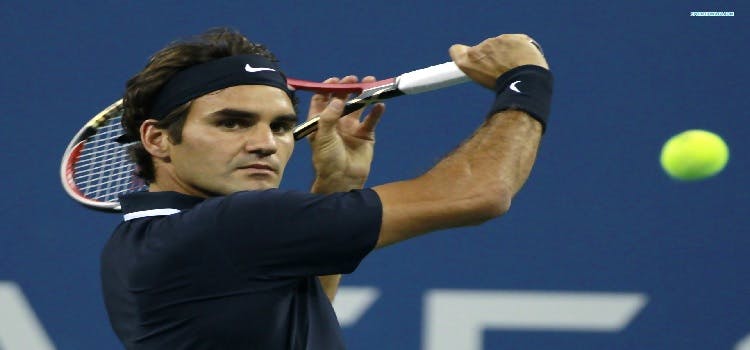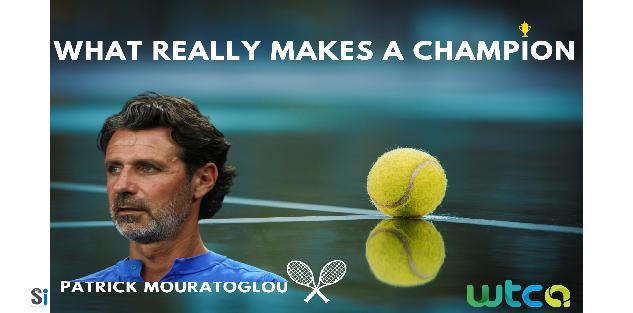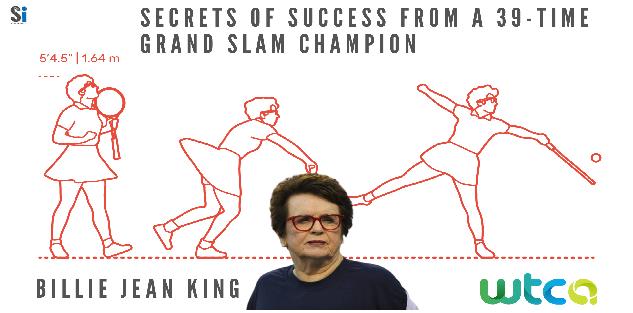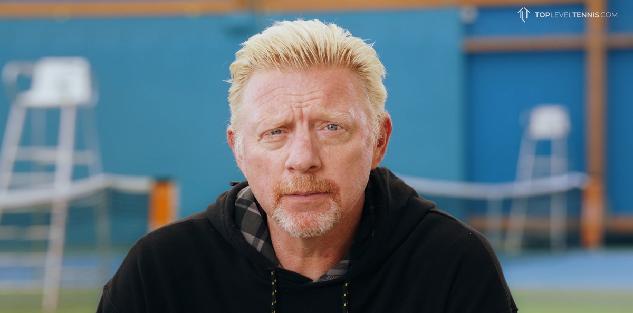Featured courses
- Four Tips to Turn Your Tennis Forehand Into a Weapon by Grant Young
- Tennis Legend Billie Jean King’s 4 Responsibilities as a Player by Grant Young
- Two Top Priorities For Success in Doubles Tennis by Grant Young
- Three of Tennis Whiz Lisa Dodson’s Tips to Improve Serves by Grant Young
- Three Elite Tennis Ball Machine Drills by Grant Young
- Three Keys For Correcting Tennis Serving Mechanics by Grant Young
- Five Tactical Tips to Win More Tennis Matches by Grant Young
- 4 Lessons Patrick Mouratoglou Learned From Coaching Serena Williams by Grant Young
- Four Effective Backhand Tennis Drills by Grant Young
- Two of Legendary Tennis Coach Paul Annacone’s Crucial Player Development Tips by Grant Young
- A Step-By-Step Guide To Mastering The Serve by Krsto Arsenijevic
- How to Dominate the Clay Court in Tennis by Krsto Arsenijevic
- 10 Essential Tennis Drills Every Coach Should Know by Brandon Ogle
- 8 Pre-Game Exercises to Prime Your Tennis Team for Competition by Neil Brown
- 7 Proven Tips To Develop Your Net Game in Tennis by Krsto Arsenijevic
- 10 Essential Tennis Drills Every Coach Should Know by Krsto Arsenijevic
- Developing Players - Two-handed backhand by Ramon Osa
- 6 Simple Warm-up Exercises For Tennis Players by Krsto Arsenijevic
- How to Beat a Serve-and-Volley Player by Krsto Arsenijevic
- How To Build Your Kinetic Chain Like Djokovic by Aiden Lefebvre
- How to neutralize a lefty in Tennis by Aiden Lefebvre
- 5 Tips To Improve Your Tennis Game Today by Krsto Arsenijevic
- Everything You Need to Know Before Buying New Tennis Shoes by Brandon Ogle
- Amp up your tennis practice with situational play by Neil Brown
- Tennis Equipment List by Brandon Ogle
- How to Master The One-handed Backhand in Tennis by Krsto Arsenijevic
- Modern High School Tennis Coaching Obstacles by Neil Brown
- Increase Your Tennis Fitness Level With 3 Easy Drills by Krsto Arsenijevic
- How to Successfully Hit a Two-Handed Backhand by Brandon Ogle
- How to Become a Grass Court Specialist in Tennis by Brandon Ogle
- How to Dominate the Hard-Court like Serena Williams by Brandon Ogle
- Hit a Drop Shot to Keep Your Opponent Off-Balance by Brandon Ogle
- New Tennis Injury Findings Linked to Neutral & Closed Stances by Oscar Wegner
- CHATTING WITH TENNIS PRO BRUCE CONNORS by Brandon
- How to Become a Mentally Strong Tennis Player by Brandon Ogle
- How to Win the Game of Angles by Hitting Cross-Court Shots by Eric Mahnke

How to Become a Grass Court Specialist in Tennis
- By Brandon Ogle
At the youth tennis level, grass court matches usually come few and far between. Traditionally known as “lawn tennis,” grass courts are much more common throughout Britain than North America. The high cost of maintenance makes them less attractive to most individuals as they are more expensive than either clay or hard courts. Making the transition from clay or hard to grass can be a difficult one, although this can be mitigated if a player is properly prepared.
Serve-and-Volley
Players that utilize the serve-and-volley approach usually see more of an advantage when it comes to competing on grass courts. Simply put, this style of play involves the server moving quickly towards the net after hitting the serve. Then, the server attempts to volley the ball back before it bounces. Obviously, this style of play won’t be effective for courts that promote longer rallies, but that is usually not the case on grass. A key determinant of this is the sole fact that grass courts play much quicker than others.
Speed
With grass courts, players need to be prepared for more than just understanding their conditioning will be tested. Rather, they should have significant knowledge on the timing and bounce of the ball. While it plays fast like hard courts, you won’t be getting high bounces due to the skidding off the grass. So, in theory, you’ll have a lower bounce that stays in the air a decent amount of time. The best solution for this is to get your swing going early and keep your racket lower.
Again, as seen with the above point, the best method is to take control and get to the net because it’s difficult to play defensive tennis on grass.
Utilize the Slice
The slice carries immense importance on grass, as this is truly where it can shine. A slice is the use of backspin placed on a groundstroke or volley. The nice thing about slices is they generally don’t bounce much when they land on your opponent’s side of the court. So the ability to hit a slice when your opponent is near the baseline can result in an automatic point. On grass courts, this can help negate the speed of the court. It may also be wise to develop a slice serve to keep your opponent on the edge.
Here, Tennis Pro Cosmin Miholca shows the topspin -slice-drop technique.
Source: Best BALL MACHINE Tennis Drills and Games
Uncommon
Unless you reside in Britain or the Northeast of the United States, it’s pretty unlikely you’ll be able to get much experience on grass courts due to all the work that goes into its upkeep. As a result of this, the only way to ensure you are prepared should a chance present itself is to practice the shots mentioned throughout this article. While most of these moves are most effective on grass, they can also be used in your game plan for matches on other courts.
Luck
When you think of grass courts, the concept of predictability won’t be at the top of the list. If you ever have the chance to watch a grass court tournament, take careful observations on how the field changes over the course of the tournament. This is one of the primary reasons why maintenance costs are so high. As more matches are played, divots and bumps start to form. These alterations on the court can create some tricky bounces. As a result, to be successful on grass you will rely on a good bit of luck to have some of these bounces go your way.
Slippery Surface
The skidding of the ball off the surface is largely due to the slippery nature of grass courts. This allows the ball to retain most of its speed after the bounce. The ball likely won’t bounce much higher than the knee, which requires a player to alter their strategy to be successful. The best way to account for this issue is to hit with power. The harder you hit, the less you will have to worry about the ball losing any speed due to the slippery nature. In addition, practice lowering your center of gravity to be able to return the low bounces.
Easy on Joints
Yes! Most likely the nicest part of grass courts is the fact that they are gentle on the knees. Playing numerous matches on hard courts can take a toll on your knees and joints. Grass courts are the complete opposite. One perfect example of this in real life is with Rafael Nadal. He has consistently claimed how the hard courts resulted in many of his knee injuries, while he has never struggled with any sort of injury playing on grass. If you have the chance, try to play more on grass rather than just hard courts for this reason.
Shorter Rallies
As I’ve mentioned multiple times, grass courts play much quicker than the other courts. The ball doesn’t lose much of its speed and plays to the skillsets of big hitters. Understand this concept and apply it to your game. If you’re normally a defensive player, avoid that mindset at all costs on grass. The rallies are predominantly brief on grass and the best way to get around that is to go for a winner with each shot. Whether it is utilizing the slice as referenced above or putting everything into a serve for an ace, you can’t be afraid to let it all out on any particular shot.
Grass Court-Specific Shoes
If you live in an area that has a few grass courts, I recommend picking up a pair of shoes that are designed for grass courts. With the slippery nature, there are going to be times where you reach out to hit a ball and may lose your footing. You need a pair of shoes that ensure this happens as infrequently as possible. The grass court season is generally short, so your options are limited. Asics, Adidas, and Nike all make solid grass court shoes that focus on the qualities of support and traction.
Grass Court Specialists
Over the years, there have been many professional tennis players that have taken their games to another level when the grass court season commenced. Here are a few of the elites:
Roger Federer – Perhaps the greatest tennis player of all-time, Federer has succeeded on every style of court, but has been nothing short of dominant on grass. He has reached the Wimbledon final nine times. He is an elite serve-and-volley player and simply doesn’t have a glaring weakness in his entire game.
Martina Navratilova – Winner of nine Wimbledon singles titles, Navratilova is one of the greatest in women’s tennis history. She had an elite serve and also utilized the serve-and-volley approach to perfection. An interesting fun fact is that she was able to win a match on the grass in Eastbourne at the age of 45.
Play Quick!
Grass courts aren’t going to be long matches. Robin Soderling, an ATP player, said this of Roger Federer: “I never played anyone playing that fast. He doesn’t have any weaknesses at all. He really deserves to be called the best player of all time.” Federer may not have the fastest serve on the tour, but by playing quick and avoiding mistakes, he is utilizing the most important aspects of a grass court specialist. Don’t waste time hoping your opponent will mess up, rather go out and hit a winner right away



